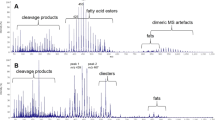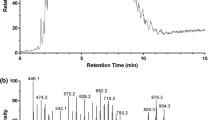Abstract
The secretion of the paracloacal glands of the American crocodile (Crocodylus acutus) contains over 80 lipophilic compounds, including saturated and unsaturated long-chain alcohols along with their formic, acetic, and butyric acid esters, and several isoprenoids. Most of these compounds were identified on the basis of mass spectra, obtained by GC-MS. In addition, identification of the major components was supported by infrared spectra obtained by GC-FTIR. Major differences are indicated in the composition of the paracloacal gland secretion of C. acutus and that of another crocodylid, the African dwarf crocodile (Osteolaemus tetraspis).
Similar content being viewed by others
REFERENCES
Attygalle, A. B.1998. Microchemical techniques, pp. 270–271, inJ. G. Millar and K. F. Haynes (eds.). Methods in Chemical Ecology, Vol. 1: Chemical Methods. Chapman & Hall, Norwell, Massachusetts.
Attygalle, A. B., and Morgan, E. D.1986. A versatile micro-reactor and extractor. Anal. Chem.58:3054–3058.
Attygalle, A. B., Meinwald, J., and Eisner, T.1992. Defensive secretion of a carabid beetle Hellouomorphoides clairvillei. J. Chem. Ecol.18:489–498.
Attygalle, A. B., Smedley, S., Meinwald, J., and Eisner, T.1993. Defensive secretion of two notodontid caterpillars (Schizura unicornis, S. badia). J. Chem. Ecol.19:2089–2104.
Burger, B. V., Le Roux, M., Spies, H. S. C., Truter, V., Bigalke, R. C., and Novellie, P. A.1981. Mammalian pheromone studies, V. Compounds from the preorbital gland of the grysbok, Raphicerus melanotis. Z. Naturforsch.36c:344–346.
Burger, B. V., Tien, F.-C., Le Roux, M., and Mo, W.-P.1996. Mammalian exocrine secretions: X. Constituents of preorbital secretion of grysbok, Raphicerus melanotis. J. Chem. Ecol.22: 739–764.
Burger, B. V., Greyling, J., and Spies, H. S. C.1999. Mammalian exocrine secretions. XIV. Constituents of preorbital secretion of steenbok, Raphicerus campestris. J. Chem. Ecol.25:2099–2108.
Buser, H.-R., Arn, H., Guerin, P., and Rauscher, S.1983. Determination of double bond position in monounsaturated acetates by mass spectrometry of dimethyl disulfide adducts. Anal. Chem. 55:818–822.
Dunn, B. S., Jr., Weldon, P. J., Howard, R. W., and McDaniel, C. A.1993. Lipids from the paracloacal glands of the Chinese alligator (Alligator sinensis). Lipids28:75–78.
Eisner, T., and Meinwald, J.1995. Chemical Ecology: The Chemistry of Biotic Interaction. National Academy Press, Washington, D.C.
Francis, G.W., and Veland, K.1981. Alkylthiolation for the determination of double bond positions in linear alkenes. J. Chromatogr.219:379–384.
Ibrahim, S. A., Avery, J.W., Weldon, P. J., and Wheeler, J.W.1998. Age-class differences in lipids from the paracloacal glands of the American alligator (Alligator mississippiensis). Z. Naturforsch. 53c:201–209.
Ihara, M., Yasui, K., Taniguchi, N., and Fukumoto, K.1990. Asymmetric total synthesis of (—)-protoemetinol, (—)-protoemetine, (—)-emetine and (—)-tubolosine by highly stereocontrolled radical cyclizations. J. Chem. Soc. Perkin Trans.1:1469–1476.
Kaplay, K. M., Sahni, R., Damoradan, N. P., and Dev, S.1980. Photochemical transformations-II. Organic iodides II: Citronellyl iodide, 2,3-dihydro-6(Z)-farnesyl and 2,3-dihydro-6(E)-farnesyl iodide. Tetrahedron36:1455–1461.
Kushlan, J. A., and Mazzotti, F. J.1989. Population biology of the American crocodile. J. Herpetol.23:7–21.
Lopez, L. C., Morgan, E. D., and Brand, J. M.1993. Hexadecanol and hexadecyl formate in the venom gland of formicine ants, Phil. Trans. R. Soc. London B.341:177–180.
Madden, B. A., and Prestwich, G. D.1994. Asymmetric synthesis of a mechanism-based inhibitor of oxidosqualene cyclase. J. Org. Chem. 59:5488–5491.
Mo, W.-P., Burger, B. V., Le Roux, M., and Spies, H. S. C.1995. Mammalian exocrine secretions: IX. Constituents of preorbital secretion of oribi, Ourebia ourebi. J. Chem. Ecol. 21:1191–1215.
Navajas Polo, C.1982. Procedimiento para la obtención de una lactona y el producto obtenido. Cuban patent #21412.
Navajas Polo, C., Rosado, A., Magraner, J., and Rodriguez, G.1988a. Estudio quimico del almizcle del genero Crocodylusque habita en Cuba. I-A. Algunos acidos grasos saturados presentes. Rev. Cubana Farm. 22:61–68.
Navajas Polo, C., Rosado, A., Magraner, J., and Rodriguez, G.1988b. Estudio quimico del almizcle del genero Crocodylusque habita en Cuba. I-B. Algunos acidos grasos insaturados presentes. Rev. Cubana Farm. 22:69–75.
Shafagati, A., Weldon, P. J., and Wheeler, J. W.1989. Lipids in the paracloacal gland secretions of dwarf (Paleosuchus palpebrosus) and smooth-fronted (P. trigonatus) caimans. Biochem. Syst. Ecol.17:431–435. CROCODILE VOLATILE COMPOUNDS 781
Weldon, P. J., and Ferguson M. J.1993. Chemoreception in crocodilians: Anatomy, natural history, and empirical results. Brain Behav. Evol.41:239–245.
Weldon, P. J., and Tanner, M. J.1991. Gular and paracloacal gland secretions of crocodilians: A comparative analysis by thin-layer chromatography. Biochem. Syst. Ecol.19:133–141.
Weldon, P. J., and Wheeler, J. W.2000. The chemistry of crocodilian skin glands, pp. 286–296, inG. C. Grigg, F. Seebacher, and C. E. Franklin (eds.). Crocodilian Biology and Evolution, Surrey Beatty & Sons, Chipping Norton, New South Wales, Australia.
Wheeler, J. W., Ibrahim, S. A., and Weldon, P. J.1999. 2,3-Dihydrofarnesyl and citronellyl esters in the paracloacal gland secretions of the brown caiman (Caiman crocodilus fuscus) from Costa Rica. Biochem. Syst. Ecol.27:27–32.
Whyte, A., Yang, Z., Weldon, P. J., Eisner, T., and Meinwald, J.1999. Reptilian chemistry: Characterization of dianeackerone, a secretory product from a crocodile. Proc. Natl. Acad. Sci. USA96:12246–12250.
Yang, Z., Whyte, A., Attygalle, A. B., Weldon, P. J., Eisner, T., and Meinwald, J.1999. Reptilian chemistry: Characterization of a family of dianeackerone-related steroidal esters from a crocodile secretion. Proc. Natl. Acad. Sci. USA96:12251–12256.
Yang, Z., Attygalle, A. B., and Meinwald, J.2000. Reptilian chemistry: Enantioselective syntheses of novel components from a crocodile exocrine secretion. Synthesis13:1936–1943.
Zhdanov, R. I., and Zhenodarova, S. M.1975. Chemical methods in oligonucleotide synthesis. Synthesis222–245.
Author information
Authors and Affiliations
Corresponding author
Rights and permissions
About this article
Cite this article
García-Rubio, S., Attygalle, A.B., Weldon, P.J. et al. Reptilian Chemistry: Volatile Compounds from Paracloacal Glands of the American Crocodile (Crocodylus acutus). J Chem Ecol 28, 769–781 (2002). https://doi.org/10.1023/A:1015288726605
Issue Date:
DOI: https://doi.org/10.1023/A:1015288726605




